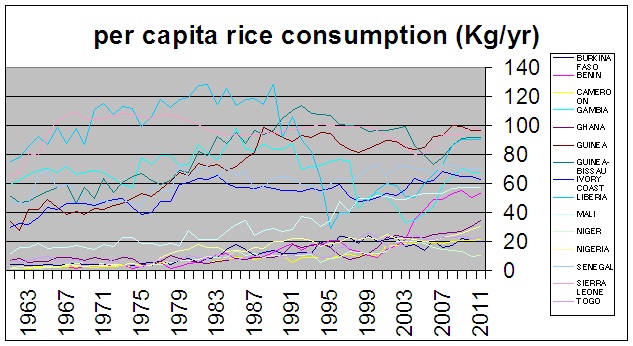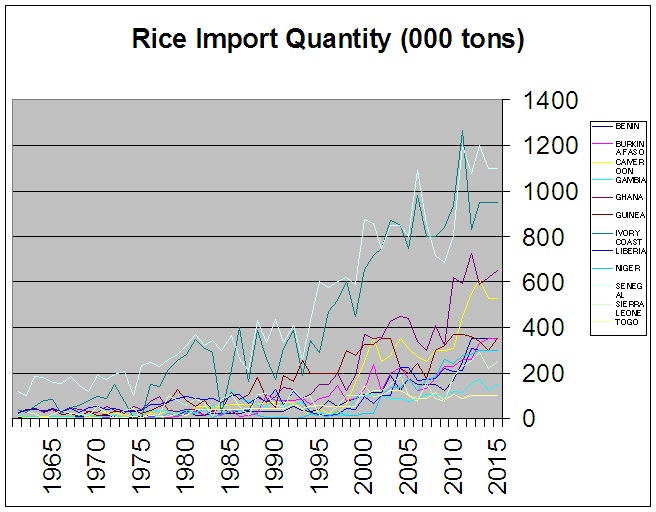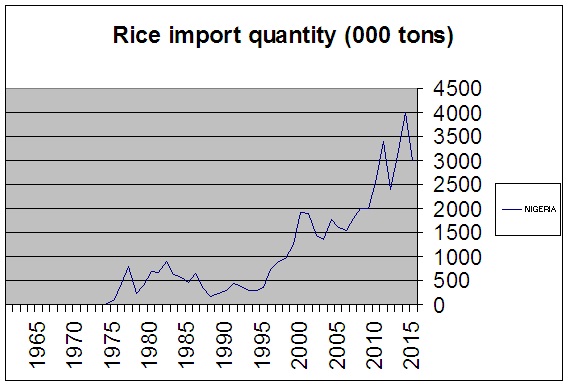Jan 14, 2016
West African Rice Import Comparisonby
Paul Conton
Rice
is an important commodity in West Africa. In some countries, Sierra
Leone, Guinea, Liberia, it is the staple food, eaten almost every day
by almost everyone, and it is very
important. In all other West African countries its consumption has been
on a steady, long-term increase as consumer preferences shift, and its
importance is therefore growing. Rice also, unlike some of the other
West African staples like cassave and yams, is a heavily
traded commodity internationally, subject to GATT, to aggressive global
marketing and the fierce
supply and demand pressures of the open market, as well as to the
manipulations of governments of consuming and producing nations. In the
2007-08 rice crisis, some exporting nations enforced an export ban to
protect their local markets, whilst importing nations scrambled to
stockpile rice for domestic food security. Rice
statistics then tell us much about a consuming nation's ability to feed
itself
and to compete in the global martketplace.
West Africa, with its heavy rainfall, swamps, fertile soils and large rural populations should be able to produce its rice needs domestically, and yet the region is a net importer. Rice is an even more important commodity in Asia, where it is the staple almost everywhere and is exported by several countries. Even a country like Japan, with relatively scarce land resources, highly technologically advanced with exports of far higher value than humble grains, a country that might perhaps profit by buying some of its food abroad rather than growing it, even Japan goes to great lengths and takes great pride in being self-sufficient in rice. Other Asian producers with yearly rice surpluses, such as Thailand, Vietnam, India, Pakistan and Burma have been laughing all the way to the bank as West Africans cue up at their doorstep to buy rice from them.
In the West African rice consumption chart below, most countries show a marked rise in per capita consumption in the years since Independence. Consumers have been turning more and more to rice as their staple in preference to yam, cassava and millet. The West African countries can be divided into three groups: the very high rice consumers (> 80 kg per person per year) are Guinea, Sierra Leone, Liberia and Guinea-Bissau. In the medium category (40-80 kg per person per year) are Benin, Mali, Ivory Coast, Senegal and Gambia. And the countries with relatively low per capita rice consumption (< 40 kg per year) are Niger, Cameroon, Burkina Faso, Togo, Nigeria and Ghana. However, if trends continue many of the low and medium rice consumers will be high rice consumers in the not-too-distant future.

Source: International Rice Research Institute
When one looks at the rice import figures, the
picture is even more dramatic. The combination of increasing rice
consumption, increasing populations and rural/urban migration has had
an overwhelming effect. All
West African countries show a steep increase in rice imports since
Independence, with a corresponding huge increase in the outlay of
precious foreign currency. According to the International Rice Research
Institute,
Sierra Leone spent 101 million United States dollars on rice
importation in 2012; Nigeria spent 1.28 billion dollars in the same
year.
Some West African economies, like Ivory Coast and Ghana can present the
defensible excuse that these imports were counterbalanced by
agricultural exports including cocoa and coffee. Others, perhaps
Gambia and Mali can contend that their climactic conditions do
not favour rice growing and their economic efforts would be better
spent elsewhere. However the high rice consumers Guinea, Sierra
Leone, and Liberia, in the heart of the West African rain belt, can
present no such arguments. Their food security is incrasingly at risk.


The table appears to show a significant correlation with figures presented earlier for West African urbanization. The top five per capita rice importers, Guinea-Bissau, Senegal, Gambia, Liberia and Ivory Coast are all in a group with the highest relative capital city populations (between 20 and 30 percent of overall national populations). Of the bottom six per capita rice importers, three, Ghana, Nigeria and Niger, had low relative capital city populations (under 10 percent of overall national populations) whilst the other three were in the intermediate range of relative capital city populations. Intuitively this makes perfect sense. If a large percentage of the national population lives in the capital city, these people will not be growing their own food, and all other things being equal will be more likely to eat imported rice.
Related...
West Africa, with its heavy rainfall, swamps, fertile soils and large rural populations should be able to produce its rice needs domestically, and yet the region is a net importer. Rice is an even more important commodity in Asia, where it is the staple almost everywhere and is exported by several countries. Even a country like Japan, with relatively scarce land resources, highly technologically advanced with exports of far higher value than humble grains, a country that might perhaps profit by buying some of its food abroad rather than growing it, even Japan goes to great lengths and takes great pride in being self-sufficient in rice. Other Asian producers with yearly rice surpluses, such as Thailand, Vietnam, India, Pakistan and Burma have been laughing all the way to the bank as West Africans cue up at their doorstep to buy rice from them.
In the West African rice consumption chart below, most countries show a marked rise in per capita consumption in the years since Independence. Consumers have been turning more and more to rice as their staple in preference to yam, cassava and millet. The West African countries can be divided into three groups: the very high rice consumers (> 80 kg per person per year) are Guinea, Sierra Leone, Liberia and Guinea-Bissau. In the medium category (40-80 kg per person per year) are Benin, Mali, Ivory Coast, Senegal and Gambia. And the countries with relatively low per capita rice consumption (< 40 kg per year) are Niger, Cameroon, Burkina Faso, Togo, Nigeria and Ghana. However, if trends continue many of the low and medium rice consumers will be high rice consumers in the not-too-distant future.

Source: International Rice Research Institute


Source:
International Rice Research Institute
In absolute terms, Nigeria is by far the biggest importer, shown for
clarity in a separate chart. But which countries present the highest
per capita rice importation. Relative to the size of their populations
which countries spend the most on imported rice? The table of 2015
rice
imports per capita reveals Guinea_Bissau in top position, with
Nigeria among the lowest per capita importers. Single-year figures may
be distorted either by a country drawing down or increasing its
internal stockpiles of rice.The table appears to show a significant correlation with figures presented earlier for West African urbanization. The top five per capita rice importers, Guinea-Bissau, Senegal, Gambia, Liberia and Ivory Coast are all in a group with the highest relative capital city populations (between 20 and 30 percent of overall national populations). Of the bottom six per capita rice importers, three, Ghana, Nigeria and Niger, had low relative capital city populations (under 10 percent of overall national populations) whilst the other three were in the intermediate range of relative capital city populations. Intuitively this makes perfect sense. If a large percentage of the national population lives in the capital city, these people will not be growing their own food, and all other things being equal will be more likely to eat imported rice.
NEXT(Sierra Leone to become Self-Sufficient in Rice Once Again)